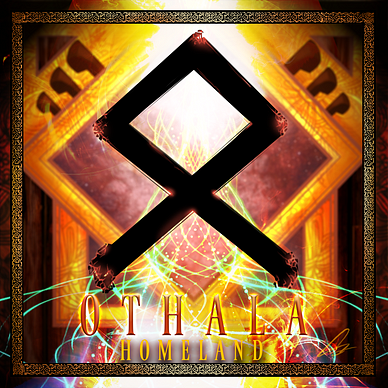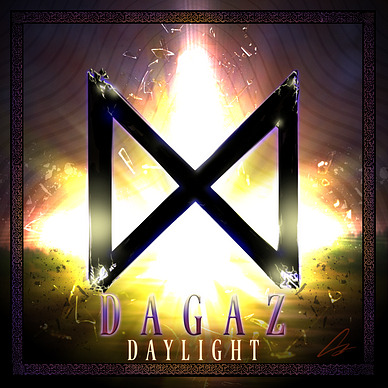The Rune Series: DAGAZ (Daylight)
The radiance of the Divine Light of Consciousness
The Runes of this series belong to the Elder Futhark, one of the oldest alphabets in recorded history. Each Rune has endless interpretations and deep meanings; while their origin and/or intent is lost to history, most interpretations come from the ‘Rune Poems’, possibly written around the 8th century. This series will explore the Runes through a personal journey and intuitive interpretation alongside knowledge collected from written works, such as ‘The Book of Runes’ (R.Blum, 1982).
Greetings Dear Reader,
Welcome back to the Rune Series where we explore the ancient Runes through a psychological, practical, spiritual and philosophical lens.
You can check out the rest of this series below:



Our corresponding Rune poem is, once again, of more recent invention and Christian connotation:
Day, the glorious light of the Creator, is sent by the Lord;
it is beloved of men, a source of hope and happiness to rich and poor,
and of service to all.
DAGAZ
DAGAZ or Daeg is the ultimate Rune, the final realisation, the bursting forth of the light of day. For all intents and purposes, it’s the Rune of awakening and enlightenment. It’s the final stage of the seed’s development and the purpose of its growth.
If you notice its shape, DAGAZ seems to be composed of two triangles intersecting at the summit. The shape draws the eye to the middle. We could dare say it represents the emergence of duality from a single point. I’ll try and elaborate on this as much as I can.
The phenomenon known as ‘Enlightenment’ is, to the Western mind, a sort of esoteric, legendary concept imported from the East. While you can find Christian mystics referencing this process, it’s usually the Buddhist and Vedic traditions that have better descriptions of what it’s all about. In my own personal experience, the Vedanta and Upanishadic texts are the best, most comprehensive sources for a linear explanation of what Enlightenment is.
For this reason, I’ll primarily use those sources as well as Dr. David Hawkins’ literary works to discuss this Rune.
The Journey Upwards
Rune Series 23/24
Third Aett: Dagaz
Meaning: ‘Daylight’, ‘Day’
Associated English letter: D
The direction and destination of the seed is up. Likewise, the destination of consciousness is towards expansion, its destiny is liberation. If we assume the spiritual stance that says the universe itself is collective consciousness, then we can hazard the hypothesis that each individual point of awareness (you) is destined to become the whole.
Maybe that’s the purpose of time itself: to facilitate the perspective of evolution. To give sense to this voyage and allow us to experience each individual stage.
It’s likely that Reality itself is quite a bit more complex than that, but that’s the best that my mind can come up with.
The fact that Enlightenment itself exists as a concept is fascinating in itself. Faith in it is, I think, similar to faith in God: it can only really be verified by direct experience. Luckily for us, some of the most ancient traditions in the history of our species give hints about it.
What’s even better is that our modern age, despite its many problems, is the only time in history (as far as we know) where access to the deepest Eastern philosophy and mystical history is available to the Western mind. This allows anyone today access to techniques and practices for the pursuit of such a quest. And yet you don’t see many people walking around with the intention to seriously pursue Enlightenment.
Dr.Hawkins talks about this by quoting the Buddha who allegedly said: “Rare is it to be born a human; rarer still is it to have heard of Enlightenment; and most rare is it to pursue Enlightenment”. But Hawkins goes a step further by saying that Enlightenment is the destiny of the spiritual seeker that is actually motivated to pursue it. He says this is because, like gravity, the future attracts one to meet it. Metaphysically this means that Enlightenment has already happened, otherwise one would not be inclined to pursue it.
Like what you’re reading? The modern world is becoming more challenging for small artists/writers. Every word you read here is crafted with love and passion (and without AI) and Your support would enable me to spend a whole lot more time doing it. If it feels right, consider donating (:
So what exactly is Enlightenment anyway?
Few claim to know.
I don’t think any answer can truly encompass the phenomenon because of the nature of language itself. Any answer, for it to be precise, has to leave out something else. By definition, enlightenment should be total. In this sense, the Vedic tradition says, Enlightenment is beyond duality.
Basically, there’s no self that can claim to be enlightened because the state itself prevents one to identified as ‘one’. This is the dissolution of the self or Ego. What this means is that if you ever happened upon someone who claims to be enlightened, you can be sure they’re either delusional or pulling your leg. That doesn’t mean there are no ‘enlightened teachers’ and I think encountering one in a lifetime would be a great gift. But these are people who would never advertise or parade it around.
I refer to Hawkins’ work again in describing this condition of non-duality. To clarify, he claims to have experienced it himself and much of his language is a mix of psychoanalytic thought and Eastern spirituality (I recommend the Upanishads for further reading). That said, I have never come across anyone else doing a better job of describing Enlightenment:
“The Glory of God is far beyond the capacity of comprehension and, instead, there is a contextual Self-identity that one is what is being comprehended, and yet there is nothing to really comprehend. At this point, description has to stop because of the duality of languaging. Transcending that final doorway required the surrender of the seeming core and source of life itself. There is the overwhelming astonishment at the discovery that all that exists is Creation as an expression of Divinity, and the field of consciousness pervades all that exists. All that exists reflects the Divinity of its Source. Paradoxically, by surrendering life, one discovers Life.
Even the presence of the physical body is too peripheral to be noticed. However, it is later rediscovered as sort of a surprise. It continues to function on its own, spontaneously and autonomously. There is no ‘self’ or primary causal agency to determine or decide its actions. Its continuance is not a matter of interest, and it just seems to ‘know’ what to do all by itself.”
(D.Hawkins, Discovery of the Presence of God, 2007, Hayhouse)
From this we can deduce that the surrender and dissolution of the individual Ego-Mind causes consciousness to return to its collective, primordial state, likely the same one the Bible describes before Adam and Eve eat from the fruit. In a word: Paradise.
Hawkins also describes that the individuality we cling to is also, on some level, an illusion. This means that, (again, on some level) there’s no one to make any decisions or choices and all occurs of its own accord.
I don’t know what to think of this personally and I think there’s not much to say because this is likely a reality that you’ll only experience at very advanced stages of awareness but, before then, the everyday life with choices and consequences, pain and pleasure, remains true and real for us.
WARNING: I can only recommend the works of Hawkins as very advanced material for the serious student. For a more spiritual approach, Buddhism and Advaita Vedanta offer practices to aid you in that quest but, as a word of caution, do NOT attempt to approach any of this material out of a desire for self-gain, pleasure or power.
Enlightenment may sound like a blissful state but its attainment involves the dissolution of the Ego, which is anything but a joke and, if done incorrectly, foolishly or without proper guidance, can lead to hellish states beyond comprehension.
Conclusion
You might ask what does any of this Eastern stuff have to do with a Norse Rune used by Vikings?
Well, historically not much, probably. However, if we accept that Enlightenment exists as a state attainable within the human experience, and by all accounts it does, then we also have to accept some of its suppositions, despite their illogical and impractical nature. One among them is that time is, on some level, non-linear. This would mean that whoever created the Runic alphabet is literally carving those shapes into the Kylver Stone (earliest known sequential listing of the Runes) right Now.
What if in some incredible, metaphysical way, the people who carved this Rune one thousand years ago, did so in order for its shape to arrive right Here and Now, in this present moment and under these digital conditions, in a story about Enlightenment, right under your eyes. And perhaps if it wasn’t a Norse Rune you wouldn’t have been attracted to reading this article.
And its discovery by You, in some way perhaps, serves the greater cosmic story of Enlightenment itself. This concept of the great interlacing of past, present and future perfectly leads us into OTHALA.
The journey is concluded. All that remains is the final Rune to bring us back home.
Blessings,
